What is WordPress Duplicator?

WordPress Duplicator is a popular plugin that facilitates the migration, cloning, and backup of WordPress sites. This plugin creates a package containing your site’s files and database, which can then be transferred to a new location, whether it’s a new domain, server, or hosting provider. It simplifies the complex process of site migration by automating the steps involved, making it accessible for users of all skill levels.
Why Use WordPress Duplicator?
Using WordPress Duplicator provides several key advantages:
- Simplifies Migration: Migrating a website traditionally involves manually transferring files and databases, which can be error-prone and time-consuming. Duplicator automates this process, reducing the risk of errors.
- Creates Backups: It’s not just for migration; you can also use it to create backups of your site. This is crucial for safeguarding your content and settings against accidental loss or corruption.
- Reduces Downtime: A well-executed migration with Duplicator minimizes downtime compared to manual methods, helping to ensure a smooth transition with minimal disruption to your site’s availability.
- Cost Efficiency: Many Duplicator plugins offer robust features at no cost or at a low price point compared to other migration tools or professional services.
Benefits of Using Duplicator
- Ease of Migration: The plugin provides a straightforward method to move your website from one location to another. It packages everything into a single file, which can be easily transferred to the new environment.
- Comprehensive Backups: Duplicator captures both the website’s files and its database in one package. This means that your themes, plugins, and settings are included, ensuring a complete backup.
- Cost-Effective: While there are premium versions, many essential features are available for free. This makes it a budget-friendly option for site owners.
- Time-Saving: The automated process is much faster than manual migration methods, allowing you to complete the migration quickly and efficiently.
- Flexibility: Besides migration, Duplicator is useful for creating staging sites for testing changes before they go live, as well as for cloning sites for development purposes.
Prerequisites for Using Duplicator
To effectively use the WordPress Duplicator plugin, ensure you meet the following prerequisites:
- A WordPress Site: The site you wish to duplicate must be running on WordPress.
- Hosting Access: You need access to the hosting environments where both the original and destination sites are located. This includes FTP/SFTP access and access to the control panel or file manager.
- Basic Knowledge: While Duplicator simplifies the process, some familiarity with WordPress, file management, and database handling is beneficial.
- Sufficient Storage Space: Ensure that both the source and destination servers have enough space to accommodate the files and database of the site being duplicated.
Top 2 Duplicator Plugins
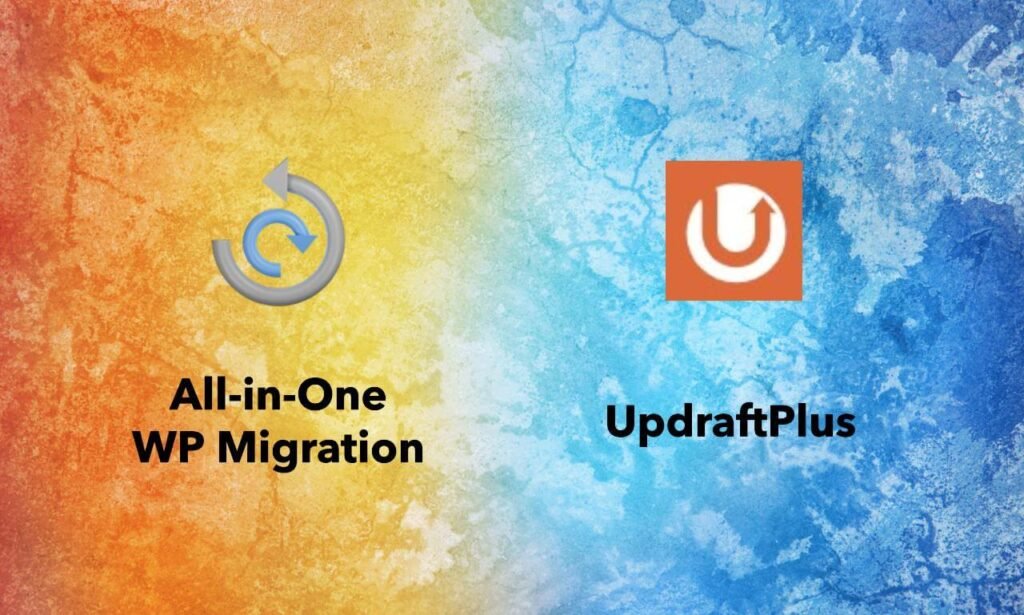
Choosing the right plugin for migrating or backing up your WordPress site can be tricky. Here’s a breakdown of two popular options, All-in-One WP Migration and UpdraftPlus, to help you decide:
| Feature | All-in-One WP Migration | UpdraftPlus |
| Main Focus | Migration (exporting entire site) | Backup & Restore (with migration features) |
| Ideal for | Simple migrations & beginners | Regular backups & occasional migrations (premium recommended) |
| Key Features | – Drag-and-drop interface for easy import/export- Supports various file formats- Exclude specific files/tables | – Automated backups to schedule- Migration & cloning capabilities – Cloud storage integration (e.g., Google Drive, Dropbox) |
| Pros | – Beginner-friendly, intuitive interface- No technical expertise required (mostly)- Free version available (limited features) | – Comprehensive backup & restoration options- Multiple storage options for backups- User-friendly interface (once set up) |
| Cons | – Limited features in free version (size limit)- May struggle with very large sites (free version) | – Migration features require premium version- Can be overwhelming for new users with many features |
| Additional Considerations | ||
| Frequency of Migrations | Not ideal for frequent migrations (free limitations) | Ideal for frequent migrations (with premium features) |
| Technical Expertise | Great for beginners with user-friendly interface | May require some understanding for full features |
| Site Size | May struggle with very large sites (free version) | Offers better backup options for large sites (premium) |
| Backup Needs | Not the primary focus, limited options in free version | Robust backup & restoration options |
Choose All-in-One WP Migration if:
- You’re a beginner and prioritize ease of use.
- You only need to migrate your site occasionally.
- Your site is relatively small (free version limitations apply).
Choose UpdraftPlus if:
Ultimately, the it depends on all your specific needs and preferences. Consider how often you plan to migrate, your technical comfort level, and your site size to make an informed decision.
Installing and Setting Up Duplicator
A. Creating a Package
- Access the Duplicator Dashboard:
- In your WordPress admin panel, navigate to “Duplicator” on the left sidebar and click on it.
- You will be taken to the Duplicator dashboard, where you can manage and create packages.
- Create a New Package:
- Click on the “Create New” button on the dashboard. This will initiate the process of creating a new backup package.
- You will be prompted to provide a name for your package. Optionally, you can add a description to help identify it later.
- Package Configuration:
- Choose whether to create a full package (including all files and database) or a custom package (selecting specific files or database tables).
- Build Package:
- Click on the “Next” button to start the package creation process. Duplicator will begin scanning your site and preparing the backup files.
B. Package Scanning Process
- Initial Scan:
- Duplicator performs an initial scan of your site to check for any potential issues that might affect the backup process. This includes checking file sizes, database tables, and server settings.
- You will see progress indicators and any warnings or errors that need to be addressed before proceeding.
- Resolve Issues:
- If the scan reports any issues (e.g., large file sizes, missing files), follow the suggested steps to resolve them. This may involve adjusting server settings or excluding problematic files.
- Confirmation:
- Once the scan is complete and no critical issues are found, you can proceed with the package creation.
C. Customizing Package Settings
- Advanced Options:
- Before finalizing the package, you can customize the settings based on your needs. Click on “Advanced” to access options for:
- Archive Format: Choose between different formats for the backup package (e.g., zip, tar).
- File Exclusions: Exclude specific files or folders from the backup if they are not needed.
- Database Exclusions: Select certain database tables to exclude if they are not required for the backup.
- Before finalizing the package, you can customize the settings based on your needs. Click on “Advanced” to access options for:
- Storage Options:
- Configure where the package will be stored after creation. Duplicator allows you to save the package to your server, download it directly to your computer, or upload it to cloud storage if integrated.
D. Starting the Backup Process
- Build the Package:
- Click on the “Build” button to start creating the backup package. Duplicator will process your site’s files and database, compress them into a single package, and prepare it for download.
- The time required will depend on the size of your site and server performance.
- Monitor Progress:
- During the build process, you can monitor progress through the Duplicator interface. The system will provide updates on the status and completion of the package creation.
- Completion:
- Once the package is built, you will see options to download the backup files. Click on the provided links to download the installer and archive files to your local computer or chosen storage location.
E. Creating a Backup with All-in-One WP Migration
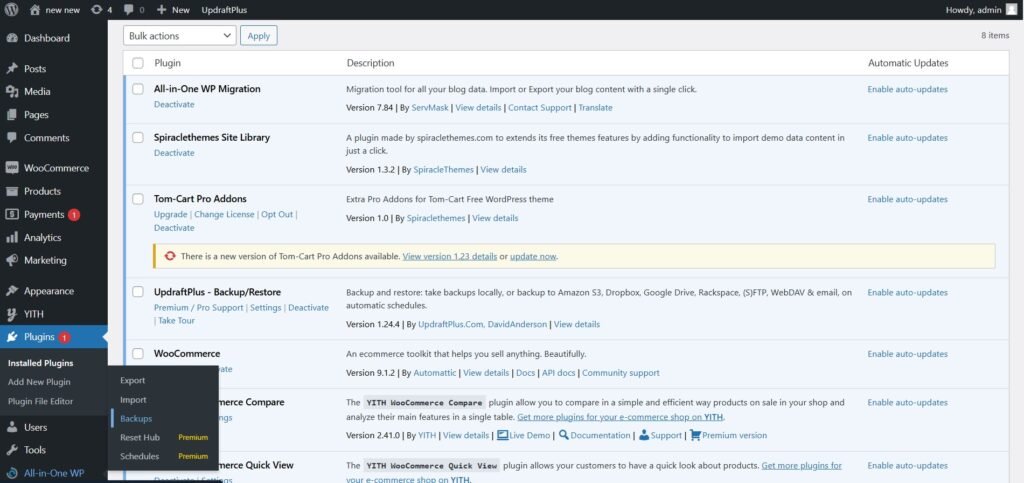
- Export Your Site:
- Go to “All-in-One WP Migration” in the WP dashboard and select the “Export” option.
- Choose the export method (e.g., file, FTP, cloud storage) and configure any desired settings.
- Perform the Export:
- Click on the “Export To” button to start the process. The plugin will generate a backup file that includes your entire site’s content, database, and settings.
- Download Backup:
- After the export is complete, download the backup file to your local storage or chosen remote location.
F. Creating a Backup with UpdraftPlus
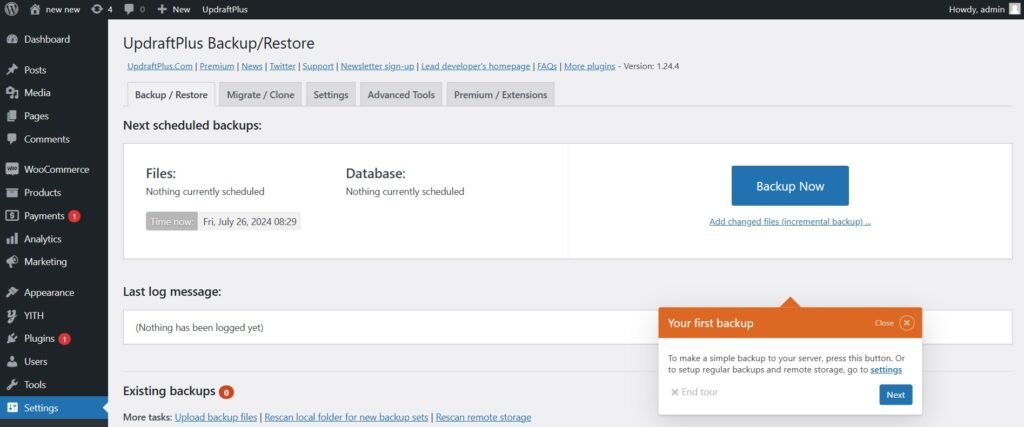
- Access UpdraftPlus Settings:
- Navigate to “Settings” and then “UpdraftPlus Backups” in your WordPress dashboard.
- Configure Backup Schedule:
- Set up a backup schedule under the “Settings” tab. Choose how frequently backups should be performed and select the types of files and database tables to include.
- Initiate Backup:
- Click on the “Backup Now” button to start creating a backup manually. Select whether to include the database and files in the backup.
- Monitor and Manage Backups:
- Once the backup is completed, you can view and manage it from the UpdraftPlus interface. Backups will be stored according to your configuration settings, and you can download or restore them as needed.
Restoring a WordPress Site with Duplicator
A. Installing Duplicator on the Target Site
- Access the WordPress Dashboard:
- Log in to the WordPress admin panel of the target site where you want to restore your backup.
- Navigate to Plugins:
- Go to the “Plugins” menu on the left sidebar and click “Add New.”
- Search for Duplicator:
- Type “WordPress Duplicator” in the search bar to find the plugin. Make sure you select the official plugin by Snap Creek.
- Install and Activate:
- Click “Install Now” and then “Activate” to enable the WordPress Duplicator plugin on the target site.
B. Uploading the Package
- Access the Duplicator Dashboard:
- In the WordPress admin panel, navigate to the “Duplicator” menu and click on it.
- Upload Backup Files:
- Locate the “Packages” section and click on the “Upload” button.
- Upload both the installer file and the archive file (the backup package created by WordPress Duplicator).
- Verify Upload:
- Ensure that the files are correctly uploaded and visible in the Duplicator dashboard.
C. Running the Installer
- Run the Installer Script:
- In your web browser, navigate to the URL where the installer file was uploaded (e.g., http://yourdomain.com/installer.php).
- This URL will launch the Duplicator installer script.
- Follow Installation Wizard:
- The WordPress Duplicator installer will guide you through a series of steps. Follow the on-screen instructions to proceed with the restoration process.
- Provide the necessary information, such as database details, to complete the restoration.
D. Completing the Installation Process
- Database Setup:
- During the installation wizard, you’ll need to enter your database information. This includes the database name, user, password, and host. Ensure these details match your new database setup.
- Run the Restoration:
- Click the “Run Deployment” button to start the restoration process. WordPress Duplicator will extract the backup files, import the database, and set up your site on the target server.
- Finalize the Restoration:
- Once the process is complete, you’ll receive a confirmation message. Remove the installer files as instructed to ensure your site’s security.
- Verify Site Functionality:
- Check your site to ensure that everything has been restored correctly. Verify that all pages, posts, and settings are intact and functioning as expected.
E. Restoring a WordPress Site with All-in-One WP Migration
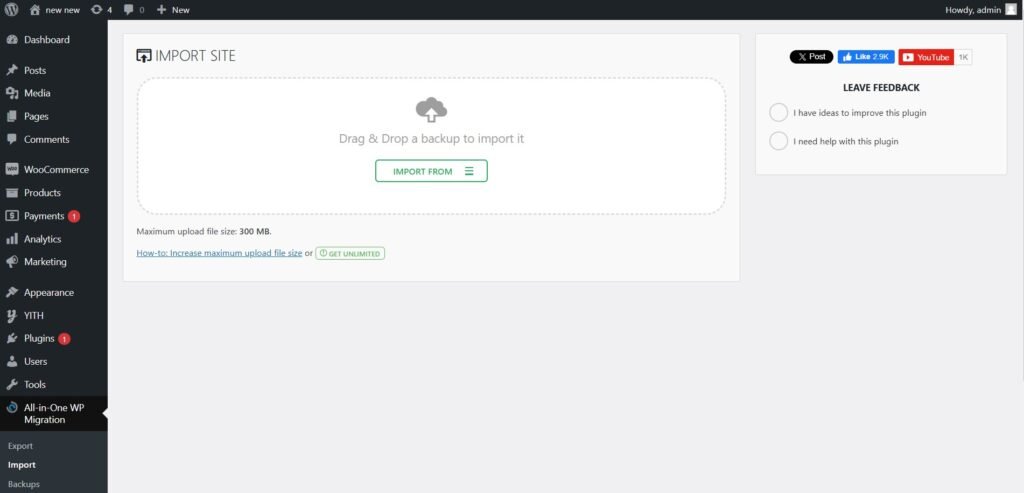
- Access All-in-One WP Migration:
- In the WordPress admin panel of the target site, go to “All-in-One WP Migration.”
- Import Backup:
- Click on the “Import” option and upload the backup file you created earlier.
- Complete the Import:
- Follow the prompts to complete the import process. All-in-One WP Migration will handle the restoration of your site’s files and database.
- Verify and Test:
- After the import is complete, check your site to ensure that the restoration was successful and everything is working properly.
F. Restoring a WordPress Site with UpdraftPlus
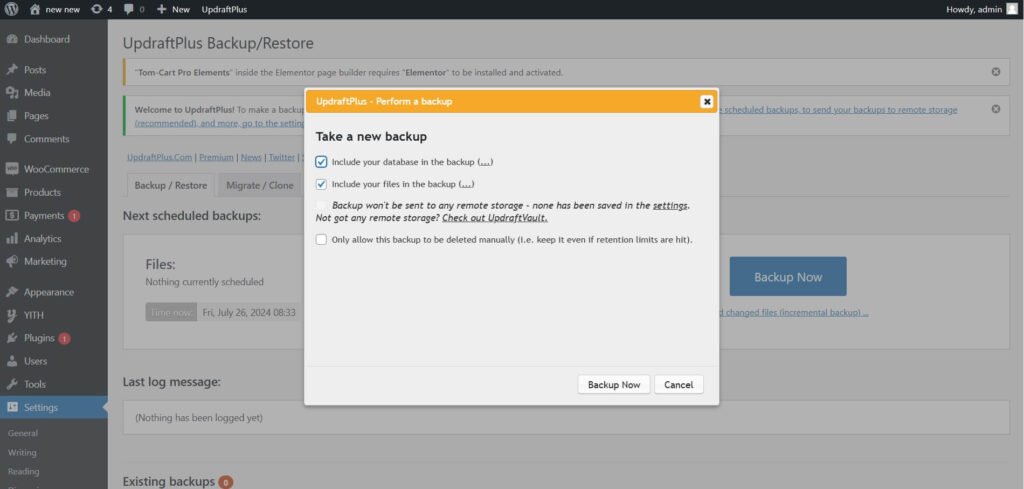
- Access UpdraftPlus Settings:
- In the WordPress admin panel, go to “Settings” and then “UpdraftPlus Backups.”
- Restore Backup:
- Click on the “Existing Backups” tab. Locate the backup you want to restore and then click on the “Restore” button.
- Select Restoration Options:
- Choose the components you want to restore, such as the database and files, and follow the prompts to start the restoration process.
- Complete and Verify:
- After the restoration is complete, verify that your site is functioning correctly and that all content has been restored.
Advanced Duplicator Features
A. Scheduling Backups
- Access Advanced Settings:
- Go to the WordPress admin panel and navigate to the “Duplicator” menu. Click on “Settings” to access advanced configuration options.
- Enable Scheduled Backups:
- In the settings, find the section related to backup scheduling. Here, you can configure the WordPress Duplicator plugin to create backups at regular intervals.
- Set Frequency and Timing:
- Choose the frequency of backups, such as daily, weekly, or monthly. Configure the timing to match your needs, ensuring that backups are created during off-peak hours to minimize server load.
- Configure Notifications:
- Set up notifications to receive alerts when backups are created or if there are any issues. This helps in keeping track of your backup status and ensures that your site is regularly backed up.
B. Cloning a WordPress Site
- Create a Clone Package:
- In the WordPress Duplicator dashboard, click on “Create New” to start the process of cloning your site. Select the option to create a full package, which includes all site files and the database.
- Configure Clone Settings:
- Customize the package settings as needed. This might include excluding certain files or tables from the clone, depending on your requirements.
- Deploy the Clone:
- Use the Duplicator installer on the target site where you want to deploy the clone. Upload the clone package and run the installer to set up the cloned site in the new location.
- Verify the Clone:
- After deploying the clone, verify that all site elements have been replicated correctly. Check for any issues and ensure that the cloned site functions as expected.
C. Migrating to a New Hosting Environment
- Prepare for Migration:
- Create a backup package using the WordPress Duplicator plugin. Ensure that you have the backup files and installer ready for the migration process.
- Install Duplicator on the New Host:
- Install and activate the WordPress Duplicator plugin on your new hosting environment.
- Upload and Install:
- Upload the backup package to the new hosting server. Run the installer script to restore the site to the new hosting environment.
- Update DNS and Test:
- Update your domain’s DNS settings to point to the new host. Test your site to ensure that everything is working correctly after migration.
D. Troubleshooting Common Issues
- File Size and Upload Limits:
- If you encounter issues with file size limits during backup or migration, check your hosting provider’s file upload limits. Adjust settings in the php.ini file or contact your hosting support for assistance.
- Database Connection Errors:
- Ensure that your database credentials are correct and that the database server is accessible. Verify the database settings in the WordPress Duplicator configuration.
- Incomplete Packages:
- If a backup package appears incomplete, review the Duplicator logs for any errors or warnings. Resolve any issues related to file or database access.
- Plugin Conflicts:
- Deactivate other plugins temporarily to check for conflicts with WordPress Duplicator. Reactivate plugins one by one to identify any that may be causing issues.
E. Tips for Optimizing Duplicator Performance
- Optimize Database:
- Regularly optimize your WordPress database to reduce its size and improve performance. This can be done using database optimization plugins or through manual queries.
- Exclude Unnecessary Files:
- When creating a backup or clone, exclude non-essential files to reduce the size of the package and speed up the process. This includes temporary files and cache directories.
- Use Efficient Storage:
- Store backup packages on fast and reliable storage solutions, such as SSDs or cloud storage, to ensure quick access and retrieval.
- Regular Updates:
- Keep the WordPress Duplicator plugin and WordPress core updated to benefit from performance improvements and bug fixes.
F. Advanced Features of All-in-One WP Migration

- Support for Large Sites:
- All-in-One WP Migration Pro version supports larger sites and more extensive backups, overcoming file size limitations present in the free version.
- Custom Export Options:
- Customize export options to exclude specific files or database tables, optimizing the export process for large or complex sites.
- Cloud Storage Integration:
- Integrate with various cloud storage providers for exporting and importing backups, offering more flexibility and storage options.
G. Advanced Features of UpdraftPlus
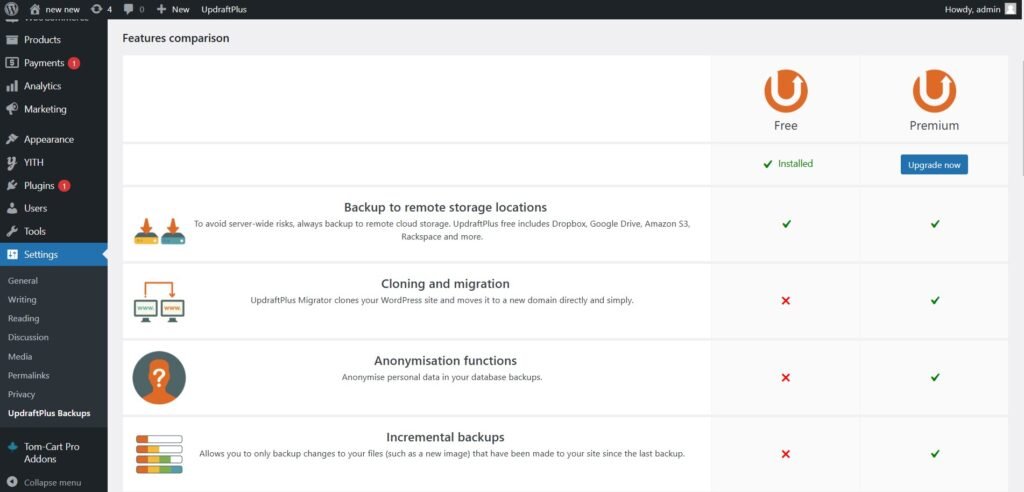
- Incremental Backups:
- UpdraftPlus Premium supports incremental backups, allowing you to back up only changes made since the last backup, reducing backup time and storage usage.
- Multi-Site Support:
- The premium version provides multi-site support, enabling you to back up and restore networked WordPress installations efficiently.
- Cloning and Migration Tools:
- UpdraftPlus Premium offers cloning and migration tools to easily move your site to a new location or hosting environment with minimal hassle.
Conclusion
In this comprehensive guide, we explored how the WordPress Duplicator plugin can revolutionize your site management tasks. We started with the basics of installing and setting up WordPress Duplicator, including how to download, activate, and understand its interface. We then delved into the detailed process of creating and restoring backups using WordPress Duplicator, ensuring you can efficiently safeguard and migrate your site. Advanced features of WordPress Duplicator, such as scheduling backups, cloning sites, and troubleshooting common issues, were also covered. Additionally, we touched upon similar functionalities provided by All-in-One WP Migration and UpdraftPlus, comparing their advanced features with WordPress Duplicator.
Ready to take control of your WordPress site’s backups and migrations? Download and install WordPress Duplicator today to start benefiting from its powerful features. If you have any questions or need further assistance, feel free to reach out to us or explore our other detailed guides. Don’t forget to share your experience with WordPress Duplicator and join the conversation on social media or in our comments section!
What is WordPress Duplicator?
WordPress Duplicator is a plugin that helps you easily migrate, copy, or clone a WordPress site. It also allows you to back up your website, making it easy to restore if needed.
How do I use Duplicator to move a WordPress site?
To move a site using Duplicator:
- Install the plugin and create a package (which includes your site files and database).
- Download the package and installer files.
- Upload them to the new hosting server and run the installer to set up the site.
Can Duplicator be used to back up my WordPress site?
Yes, Duplicator can be used to create complete backups of your WordPress site, including the database and all site files. You can store the backup locally or move it to another server as needed.
Is WordPress Duplicator free to use?
Duplicator offers both a free and a premium version. The free version allows for basic site migrations and backups, while the premium version provides additional features like scheduled backups, cloud storage integrations, and larger site migrations.
What should I do if the Duplicator migration fails?
If a migration fails, check the following:
- Ensure your server meets the plugin’s requirements.
- Verify that file permissions are correct.
- Check for server timeout issues. If problems persist, Duplicator provides detailed error logs to help diagnose the issue, or you can seek help from their support team.









